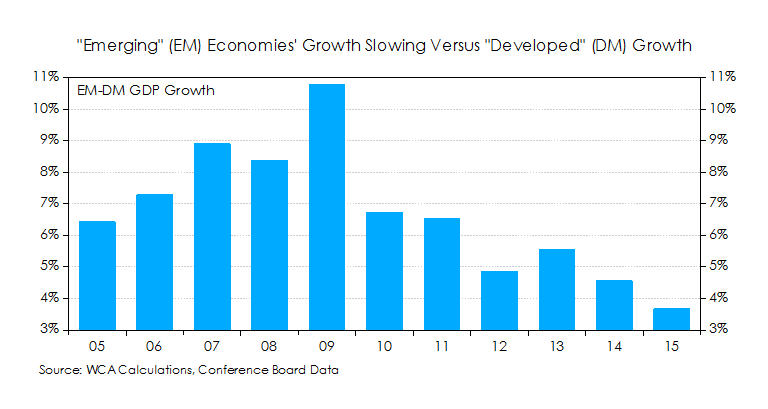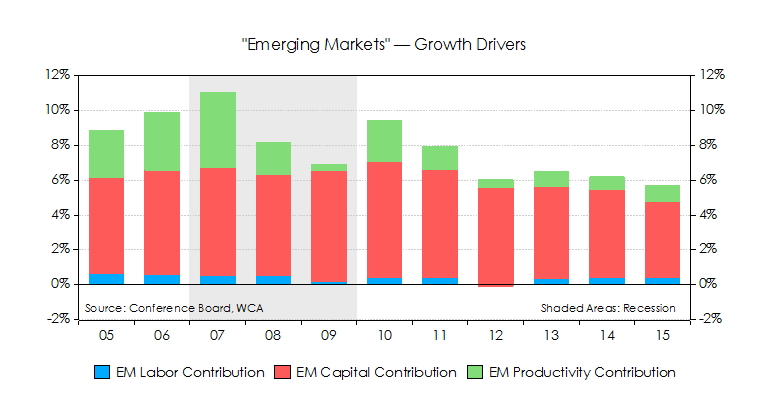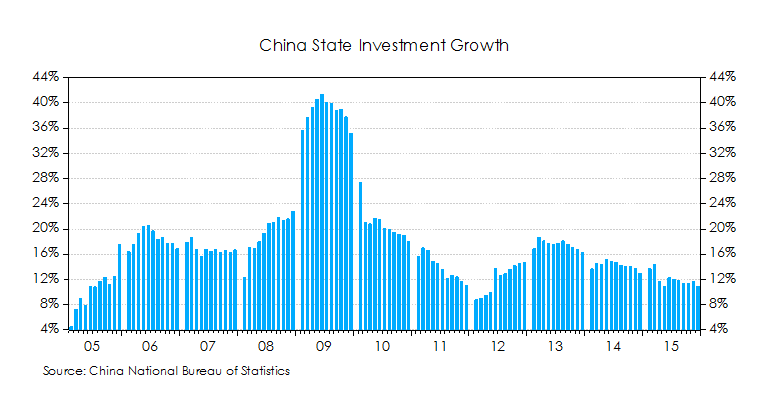Monday Morning Minute 021317
THE WEEK AHEAD
President Trump addressed Chinese and Japanese currencies last week and reiterated his call for a “level playing field” for currencies. This week we revisit China and emerging markets where we remain underweight in the diversified core of asset allocation portfolios.
MACRO VIEW
Emerging markets (EM) are delivering less growth than they used to, but remain risky. Chart 1 below shows how EM growth is converging with developed markets in recent years.
Potential growth is dampened by slipping productivity (green) and capital investment (red). These factors explain most of the moderation in EM growth in recent years. Rapid credit growth accompanied large increases in Chinese investment in infrastructure from 2000-2009 (Chart 2).
Today, we see that China still exercises sway over global demand. Chart 3 shows how changes in Chinese state spending followed the same broad outlines as EM growth since 2005. Early in 2016, the Chinese government announced a Keynsian-style stimulus to shore up faltering growth. That stimulus boosted global demand, commodity prices, and inflation measures throughout last year. Even today, we see that most of the near-term indicators out of China are favorable. These non-Chinese government sources of data seem to paint a picture of modestly positive momentum early in 2017 for China. This bodes reasonably well for emerging markets, in general, although it does not signal the “all clear”, in our opinion.
Chart 3
According to Bloomberg:
- “The latest China Satellite Manufacturing Index reading for January was 52.0, up from 51.0 in December and the highest level since mid-2011.Industrial output and capital spending decelerating, and consumption picking up.”
- “The World Economics China Sales Managers’ Index came in at 51.4 in January, edging up from 51.2 in December.”
- “The Market News International China business conditions survey rose to 55.9 in December, following November’s 53.1 reading.”
- “China’s NBS manufacturing PMI came in at 51.3 in January, a tick down from 51.4 in December but above the consensus forecast of 51.2… That points to continued expansion in the manufacturing sector in the first month of 2017”
- “The flash reading for South Korea’s exports rose 11.2% from a year earlier in January after a 6.4% increase in December, signaling stronger global demand. China’s exports tend to move roughly in line with Korea’s…”
While emerging economies continue to offer more growth than developed, we remain underweight EM. We moved from a zero weight to an underweight position at the start of this year. Our models suggest undervaluation for emerging markets, but we are yet to see a compelling turn in growth rates.
Not only are growth rates converging, but longstanding EM risk factors remain. Rapid accumulation of credit increases risk and total debt has been rising faster than EM output recently. Higher debt loads, coupled with limited government ability to respond to shocks, increases EM’s cost of capital. In turn, capital investment and productivity growth are both contributing to slower growth. This negative cycle began with a credit-driven boom and will take time to play out.
ECONOMIC RELEASES THIS WEEK
| Date | Report | Period | Survey | Prior |
| Monday, Feb 13: | No Economic Releases | |||
| Tuesday, Feb 14: | Janet Yellen testifies before Senate Banking Committee | |||
| Wednesday, Feb 15: | Janet Yellen testifies before House Financial Services Committee | |||
| Consumer Price Index M/M | Jan | — | 0.3% | |
| Consumer Price Index Y/Y | Jan | — | 2.1% | |
| CPI ex food and energy M/M | Jan | — | 0.2% | |
| CPI ex food and energy Y/Y | Jan | — | 2.2% | |
| Retail Sales M/M | Jan | — | 0.6% | |
| Retail Sales ex autos M/M | Jan | — | 0.2% | |
| Retail Sales ex autos and gas M/M | Jan | — | 0.0% | |
| Industrial Production M/M | Jan | — | 0.8% | |
| Manufacturing M/M | Jan | — | 0.2% | |
| Capacity Utilization Rate | Jan | — | 75.5% | |
| Empire State Manufacturing Survey | Feb | — | 6.5 | |
| Business Inventories M/M | Dec | — | 0.7% | |
| Housing Market Index | Feb | — | 67 | |
| Thursday, Feb 16: | Housing Starts | Jan | — | 1.226 M |
| Building Permits | Jan | — | 1.21 M | |
| Weekly Jobless Claims | 2/11 | — | 234 K | |
| Philadelphia Fed Business Survey | Feb | — | 23.6 | |
| Friday, Feb 17: | Leading Indicators | Jan | — | 0.5% |
| Source: Bloomberg |
ASSET ALLOCATION PORTFOLIO POSTURE
Based on our long-run capital market expectations, the “core” equity allocation in portfolios are underweight foreign equities / overweight large cap domestic growth, and underweight REITs / overweight Gold. The “core” bond allocation is underweight long-term Treasuries / overweight corporate high-yield bonds.
Based on shorter-term expectations, the “tactical” allocation within portfolios is underweight bonds / overweight stocks.
Kevin Caron, CFA, Portfolio Manager
Chad Morganlander, Portfolio Manager
Matthew Battipaglia, Analyst
Suzanne Ashley, Junior Analyst
973-549-4052
Disclosures
WCA Fundamental Conditions Barometer Description: We regularly assess changes in fundamental conditions to help guide near-term asset allocation decisions. The analysis incorporates approximately 30 forward-looking indicators in categories ranging from Credit and Capital Markets to U.S. Economic Conditions and Foreign Conditions. From each category of data, we create three diffusion-style sub-indices that measure the trends in the underlying data. Sustained improvement that is spread across a wide variety of observations will produce index readings above 50 (potentially favoring stocks), while readings below 50 would indicate potential deterioration (potentially favoring bonds). The WCA Fundamental Conditions Index combines the three underlying categories into a single summary measure. This measure can be thought of as a “barometer” for changes in fundamental conditions.
The information contained herein has been prepared from sources believed to be reliable but is not guaranteed by us and is not a complete summary or statement of all available data, nor is it considered an offer to buy or sell any securities referred to herein. Opinions expressed are subject to change without notice and do not take into account the particular investment objectives, financial situation, or needs of individual investors. There is no guarantee that the figures or opinions forecasted in this report will be realized or achieved. Employees of Stifel, Nicolaus & Company, Incorporated or its affiliates may, at times, release written or oral commentary, technical analysis, or trading strategies that differ from the opinions expressed within. Past performance is no guarantee of future results. Indices are unmanaged, and you cannot invest directly in an index.
Asset allocation and diversification do not ensure a profit and may not protect against loss. There are special considerations associated with international investing, including the risk of currency fluctuations and political and economic events. Investing in emerging markets may involve greater risk and volatility than investing in more developed countries. Due to their narrow focus, sector-based investments typically exhibit greater volatility. Small company stocks are typically more volatile and carry additional risks, since smaller companies generally are not as well established as larger companies. Property values can fall due to environmental, economic, or other reasons, and changes in interest rates can negatively impact the performance of real estate companies. When investing in bonds, it is important to note that as interest rates rise, bond prices will fall. High-yield bonds have greater credit risk than higher-quality bonds. The risk of loss in trading commodities and futures can be substantial. You should therefore carefully consider whether such trading is suitable for you in light of your financial condition. The high degree of leverage that is often obtainable in commodity trading can work against you as well as for you. The use of leverage can lead to large losses as well as gains.
All investments involve risk, including loss of principal, and there is no guarantee that investment objectives will be met. It is important to review your investment objectives, risk tolerance and liquidity needs before choosing an investment style or manager. Equity investments are subject generally to market, market sector, market liquidity, issuer, and investment style risks, among other factors to varying degrees. Fixed Income investments are subject to market, market liquidity, issuer, investment style, interest rate, credit quality, and call risks, among other factors to varying degrees.
This commentary often expresses opinions about the direction of market, investment sector and other trends. The opinions should not be considered predictions of future results. The information contained in this report is based on sources believed to be reliable, but is not guaranteed and not necessarily complete.
Washington Crossing Advisors LLC is a wholly owned subsidiary and affiliated SEC Registered Investment Adviser of Stifel Financial Corp (NYSE: SF).






